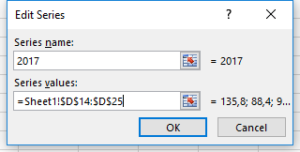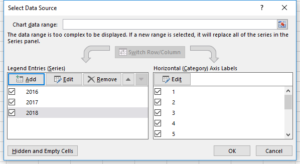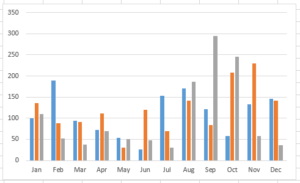It is of course possible to show more than one series in a bar graph. This is especially easy and useful when the data series to visualize are organized according to the same categories or labels.
Let's come back to our previous example. In the original table, the precipitations for 2016, 2017 and 2018 were recorded every month. We thus have 12 categories (jan, feb, mar...) which are common to each recorded year. This makes it possible to create a clustered graph in which the data from January 2016, January 2017 and January 2018 will be grouped, and so on for the others months. Let's create this chart.
 We start in the same manner as we did previously for the graph with single data series. In the
We start in the same manner as we did previously for the graph with single data series. In the Charts section of the Insert ribbon, click the icon Insert Column or Bar Chart and choose the type of chart you would like to use (here we use the one at the top left corner of the menu Clustered Column).
 A blank chart appears. Right-click in it and click
A blank chart appears. Right-click in it and click Select Data.... In the new dialog box called Select Data Source, click Add under Legend Entries (Series). The next box helps you define your data series. Under Series name, type in "2016". Under Series values, select the range of data to display (D2:D13). Finish by clicking OK.
Download the original table here.





